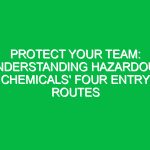Introduction
Demolishing, often referred to as demolition, is a critical process within the construction and engineering sectors. It encompasses the tearing down of buildings and structures, making way for new projects or renovations. In the Health, Safety, and Environment (HSE) domain, understanding the nuances of demolition is vital, not only for regulatory compliance but also for ensuring the safety of workers and the surrounding community. This article aims to provide a comprehensive overview of the definition of demolition, its relevance to HSE compliance, and the best practices that should be adopted to mitigate risks associated with the process.
Understanding Demolition in the HSE Context
Demolition is more than just the physical act of dismantling a structure. It involves a series of planned steps and considerations aimed at minimizing risks and ensuring safety. In the context of HSE, demolition can be defined as:
- The systematic process of removing structures or parts of structures.
- The assessment and management of potential hazards associated with the demolition process.
- The implementation of safety measures to protect workers, the public, and the environment.
The relevance of demolition in the HSE domain cannot be overstated. Each demolition project carries inherent risks, including structural failures, exposure to hazardous materials, and environmental impacts. Therefore, it is essential to adopt a comprehensive HSE framework to guide demolition activities.
Key Aspects of Demolition Relevant to HSE
1. Planning and Preparation
Before any demolition work begins, thorough planning is essential. This phase includes:
- Site Assessment: Evaluating the site for potential hazards, including underground utilities, asbestos, and structural weaknesses.
- Risk Assessment: Identifying risks associated with the demolition process and developing strategies to mitigate them.
- Environmental Considerations: Assessing the environmental impact of the demolition and planning for waste management and recycling.
A well-prepared demolition plan will include detailed procedures for safely executing the demolition while minimizing risks to health and safety.
2. Safety Measures and Best Practices
Implementing robust safety measures is fundamental in the demolition process. Some best practices include:
- Personal Protective Equipment (PPE): Ensuring all workers are equipped with appropriate PPE, such as hard hats, gloves, eye protection, and respiratory gear.
- Training and Competence: Providing thorough training for all personnel involved in demolition, ensuring they are competent in recognizing hazards and responding to emergencies.
- Emergency Procedures: Establishing clear emergency response procedures, including evacuation routes and communication plans.
An anecdote from a demolition project highlights the importance of safety measures. During a large-scale demolition of an old factory, the team conducted a comprehensive site assessment that revealed the presence of asbestos. Thanks to their planning and the implementation of strict safety protocols, they were able to safely remove the hazardous material before proceeding with the demolition, thereby preventing potential health risks to workers and the community.
3. Monitoring and Compliance
Compliance with health and safety regulations is non-negotiable in demolition projects. Regular monitoring of safety practices and adherence to industry standards is crucial. This includes:
- Regular Inspections: Conducting frequent inspections of the site to ensure compliance with safety regulations and the effectiveness of safety measures.
- Documentation: Keeping detailed records of safety meetings, training sessions, and incidents to track compliance and identify areas for improvement.
- Engaging with Regulatory Bodies: Maintaining open communication with health and safety regulators to ensure all practices meet legal requirements.
By fostering a culture of safety and accountability, companies can significantly reduce the likelihood of accidents and enhance overall compliance.
Potential Hazards and Risks in Demolition
Understanding the potential hazards associated with demolition is key to developing effective risk management strategies. Some common hazards include:
- Structural Instability: The risk of a building collapsing unexpectedly during demolition can pose significant threats to workers and bystanders.
- Exposure to Hazardous Materials: Workers may encounter dangerous substances such as asbestos, lead, or chemicals, necessitating careful handling and disposal.
- Noise and Vibration: High noise levels and vibrations can affect both workers and the surrounding community, leading to health issues and complaints.
- Environmental Impact: Demolition can result in dust, debris, and waste, which can harm the environment if not properly managed.
Each of these hazards requires proactive measures to mitigate risks. For instance, using dust suppression techniques, such as water spraying, can help reduce airborne particles during demolition.
Regulations and Standards Governing Demolition
The demolition industry is governed by a myriad of regulations and standards designed to protect health and safety. Some key regulations include:
- Health and Safety at Work Act 1974 (UK): This legislation mandates that employers ensure the health and safety of employees and others affected by their work.
- Control of Asbestos Regulations 2012 (UK): These regulations require that any work involving asbestos is carried out by licensed contractors and that proper procedures are followed.
- OSHA Standards (USA): The Occupational Safety and Health Administration (OSHA) outlines specific standards for demolition work, including safety protocols and hazard communication.
Understanding and complying with these regulations is essential for any demolition project. Failure to adhere can result in legal repercussions, financial penalties, and, most importantly, injuries or fatalities.
Conclusion
In summary, understanding the definition of demolition within the HSE context is crucial for ensuring safe and compliant practices in the construction industry. From thorough planning and risk assessment to the implementation of safety measures and adherence to regulations, every aspect plays a pivotal role in safeguarding workers, the public, and the environment.
The importance of defining and understanding demolition cannot be overstated. It not only promotes compliance with health and safety regulations but also fosters a culture of safety that can lead to better outcomes in the construction industry. As we move forward, it is imperative for industry stakeholders to continue prioritizing safety, investing in training, and embracing best practices to create a safer working environment for all.


